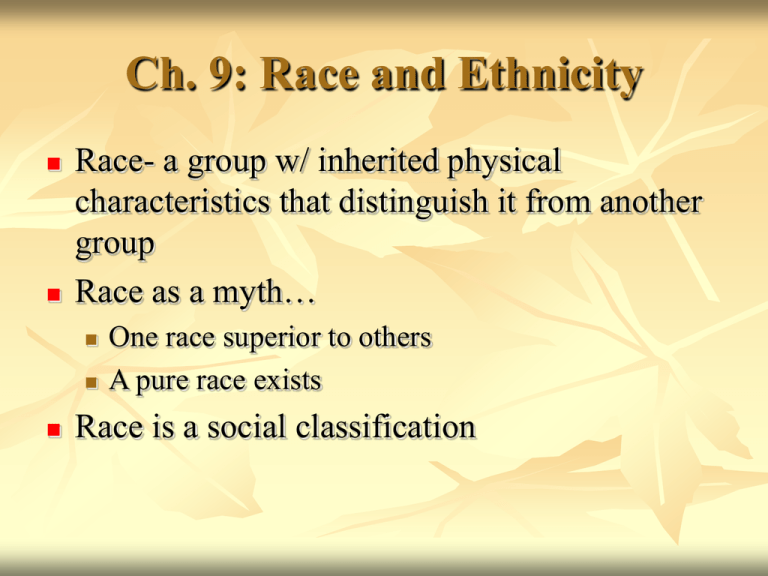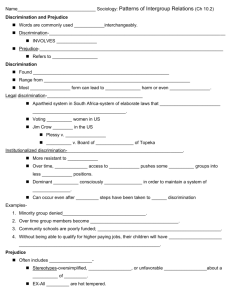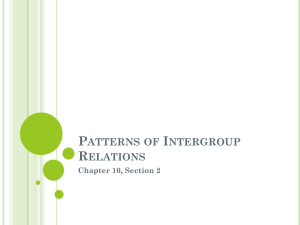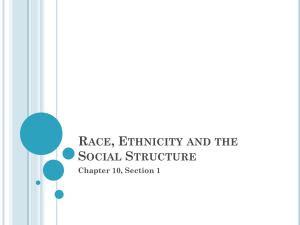Ch. 12: Race and Ethnicity
advertisement

Ch. 9: Race and Ethnicity Race- a group w/ inherited physical characteristics that distinguish it from another group Race as a myth… One race superior to others A pure race exists Race is a social classification Ethnic groups Ethnicity refers to cultural charac., people identify w/ one another on basis of common ancestry and cultural heritage Minority groups people who are singled out for unequal treatment and who regard themselves as objects of collective discrimination Dominant group those who do the discriminating; the group w/ the most power, privilege and social status Emergence of minority groups Expansion of political boundaries Migration- voluntary or involuntary Shared characteristics of minority groups Membership in group is ascribed Physical/cultural traits that distinguish them looked down on by dominant group Unequally treated by dominant group Tend to marry w/in own group Tend to feel strong group solidarity Ethnic identity Factors related to stronger sense of ethnic identity Smaller in #, lesser power, different from nat’l identity, discrimination Ethnic work- how people construct their ethnicity Melting pot Prejudice and discrimination Common around the world Discrimination- an action- unfair treatment directed against an individual or group Individual discrimination- negative treatment of one person by another Institutional discrimination- negative treatment of a minority group that is built into society’s institutions Home mortgages/ car loans/ health care Racism- discrimination based on race Prejudice- an attitude or prejudging, usually in a negative way Each group thinks others are inferior in some way Older/less educated more prejudiced than younger/more educated Theories of prejudice Psychology- factors inside the individual Frustration and scapegoats The authoritarian personality Sociology- factors outside the individual Functionalism The Nazis Sherif study (1953) Conflict theory Groups pitted against one another Capitalists keep workers insecure Capitalists exploit racial/ethnic strife Split labor market- workers divided among racial-ethnic and gender lines Symbolic interactionism Labels create prejudice Labels cause selective perception Stereotypes and discrimination create a selffulfilling prophecy We learn prejudice thru our interaction w/ others Global patterns of intergroup relations Genocide- dominant group tries to destroy the minority Population transfer Indirect- make life unbearable for members of a group so they leave “voluntarily” Direct- dominant group expels a minority Internal colonialism- how a country’s dominant group exploits minority groups for its economic advantage Segregation- separation of racial/ethnic groups Assimilation- the process by which a minority is absorbed into the mainstream culture Forced vs. permissible assimilation Multiculturalism (pluralism) Race/ethnic relations in the U.S. White Europeans- 68% of pop. Viewed as inferior when from countries other than England (white ethnics) How did white ethnic groups overcome discrimination? Immigrants dropped customs/language Latinos- 13% of pop. Largest minority group in U.S. 66% concentrated in 4 states U.S. one of largest Spanish speaking nations in the world Country of origin significant Separated by social class, underrepresented in politics African Americans- 12% of pop. Struggle for civil rights Jim Crow laws segregated blacks/whites Rosa Parks, MLK Jr. 1964- Civil Rights Act Currently- lag behind in education, politics, and economics Asian Americans- 4% of pop. No unifying race or culture 1882- Chinese Exclusion Act Japanese relocation camps Currently- highest average income Poverty not evenly distributed Kids most likely grow up w/ two parents (compared to all other groups) High rate of college graduation Native Americans- less than 1% of pop. Variety of cultures Treaties, genocide, population transfer Separatism- separate gov’t, didn’t join U.S. High rates of unemployment and poverty Highest suicide rate (of all groups)



![Race_in_Sociology[1]](http://s2.studylib.net/store/data/009990757_1-d83a33e1300c6112e4d820319aa261ea-300x300.png)



